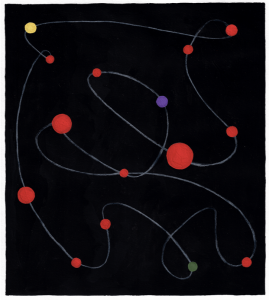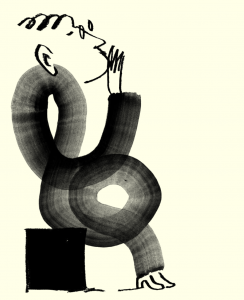Brian Dillon is an Irish writer, based in London, who has curated exhibitions for Tate and Hayward galleries. His books include Suppose a Sentence, Essayism and In the Dark Room. Dillon’s latest, Affinities, is a series of linked essays on the images that have stayed with him over many years, be they artworks, scientific illustrations, film stills or family photographs. The following piece is taken from the newly published work, a vivid list interweaving art and memory that has been revised for Port, true to its ever-changing and never-to-be-complete nature

“The work is the death mask of its conception”, Walter Benjamin writes in The Writer’s Technique in Thirteen Theses. It’s a doleful (or is it perhaps hopeful?) statement about relations between art and intention, but Benjamin’s aphorism also points to a mundane fact about the writing life: you quickly forget about the work that might have been. In my book Affinities, I’ve tried to describe my attachment to certain images – artistic, cinematic, scientific, familial, pop-cultural – and how they might connect or affiance to one another. At the end of the book: a list, or imaginary collage, of pictures not mentioned elsewhere, but which would have made for a completely different volume. (The entries are linked by manicules: those small typographic pointing hands that say to a reader: look here, pay attention, proceed.) This list, at least in my own mind, keeps changing and can never be complete. And so here is one possible revision, with additions and subtractions – a glimpse of the ghost book never to be written now.
☛Every single frame of Sergei Parajanov’s 1969 film The Colour of Pomegranates, which stages in ravishing tableaux (and almost no dialogue) the life of 18th-century Armenian poet Sayat-Nova. Picturesque ruins and stately costumed figures like dancers. A library filled with books that weep. The fruit of the title, bleeding onto white fabric. A kiss from a peacock. A choir of silver-haired children wielding antlers. The urge watching this film now: to screenshot everything in an effort not to forget. ☛An Edwardian postcard showing in sepia a young woman in a nightdress, her partially bare arms raised above her head and her long thick hair let loose. On the reverse, this legend in neat blue script: “She would make a bad wife for an old man.” I found the postcard at a market stall in Dublin 30 years ago. For a long time it migrated as a bookmark among the notebooks in which I was trying to imagine what it would be like to be a writer. There is no other handwriting, no indication who this woman was, where the photograph was taken or who wrote that smirking sentence about a turn-of-century pinup. She is lost now somewhere in my library, stuck carelessly in a book I cannot find, but I promised long ago that one day I would put her in a book of mine. ☛David Bowie in the video for his 1979 single ‘DJ’, pushing his way grinning through a real, impromptu crowd on a London street and seeming, as he gets free into the foreground, to settle his features into an expression derived from the languid allure of Elvis Presley, Marlon Brando, Lauren Bacall, Mick Jagger – and David Bowie. ☛I was about four years old, and from the street I saw a man lying under a car, with his head in flames. Overcome with fear and guilt, I told nobody. Years later the truth occurred to me: it was just a garage mechanic using a blowtorch. ☛Tortured variant on a melancholic pose that goes back at least to Albrecht Dürer: Irm Hermann as Marlene in Rainer Werner Fassbinder’s 1972 film The Bitter Tears of Petra von Kant. Ghost-pale in her black dress and helmet of red hair, Marlene the implausible but compelling and silent masochist watches jealously as her fashion-designer boss accumulates lovers and familial dramas. Marlene lowers her head and raises her right hand against a glass partition: tortured mime, agony in semaphore. ☛Jacques Henri Lartigue, aged no more than 10, photographs, sometime between 1902 and 1904, his cat Zizi, who is leaping vertically, all legs extended, to catch a ball. ☛Denis Lavant dancing to ‘The Rhythm of the Night’ at the end of Claire Denis’s Beau Travail (1999) – of course. ☛In the pages of Virtue’s Catholic Encyclopaedia, a small black-and-white image of a Victorian or Edwardian actress playing Lady Macbeth: distraught, gesticulating, her pale gown darkly streaked. Quite the most troubling image in my childhood – who was this woman and why was she covered in blood? ☛After Lady Macbeth, the most disturbing image from my childhood was the unseen one attached to a card my mother placed in my bedroom when I was about 10 years old. A lavishly tasteless holographic picture of a bust of the Irish saint – he had been canonized only a few years earlier – Oliver Plunkett, who was hanged, drawn and quartered at Tyburn in 1681. On the reverse of the card was a short account of his execution, concluding in a singularly grotesque detail: his bowels taken out and burned before his eyes. The image with which I would sometimes torture myself before going to sleep. Around this time, like many Irish schoolchildren, I was taken to St. Peter’s church in the town of Drogheda, to see the martyr’s preserved head. ☛A Polaroid by Andrei Tarkovsky showing his wife Larissa, attended by their dog Dakus, standing by a fence, most likely at their holiday home in Myasnoe, Russia, in the early 1980s. Trees in the distance, a hint of mist (or is it the medium’s fading colours?) in the top left corner, the golden earth raked by long shadows. Sometimes I think Tarkovsky’s Polaroids may be the most sheerly beautiful photographs I know. ☛A series of abstract line drawings made by Francis Picabia to accompany in 1924 the publication of seven Dada manifestos by Tristan Tzara. When I was about 16, I found a translation of this book in my local library, and in the months that followed used to try and copy, in the margins of school textbooks, the curving and zigzag lines that here and there suggest bodies. They were, and perhaps still are, the only things I could ever draw, aside from a passable rendition of the head and shoulders, but not the body, of Betty Boop. ☛In one of Derek Jarman’s Super 8 films of the late 1970s, in which hieratic, masked figures disport themselves round a bonfire: the sudden appearance, in ghostly Monroe drag, of the future (fleeting) 1980s pop star Marilyn. ☛In a book I own about strange weather and anomalous precipitation, a line drawing of a bemused young man around whom are falling ragged, flattish snowflakes the size of dinner plates. ☛The eau-de-nil apparition, coming in through French windows, of Elvira the languorously witty and prankish spectre (played by Kay Hammond) in David Lean’s 1945 film of Noël Coward’s play Blithe Spirit – the dead come back to flirt and mock and lure us away. ☛
Brian Dillon’s Affinities is published by Fitzcarraldo Editions

This article is taken from Port issue 32. To continue reading, buy the issue or subscribe here




